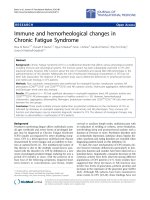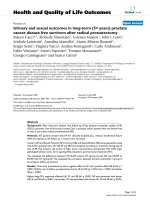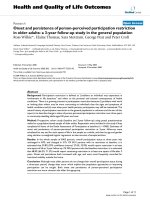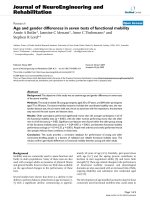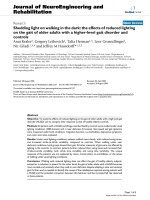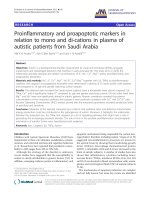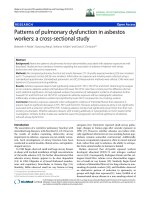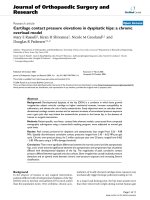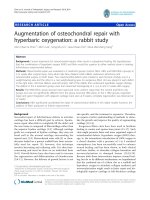báo cáo hóa học:" HIV-1-infected and HIV-1-uninfected adults in Burkina Faso: a cross-sectional study" pptx
Bạn đang xem bản rút gọn của tài liệu. Xem và tải ngay bản đầy đủ của tài liệu tại đây (581.52 KB, 44 trang )
Journal of the International
AIDS Society
This Provisional PDF corresponds to the article as it appeared upon acceptance. Fully formatted
PDF and full text (HTML) versions will be made available soon.
Activation and maturation of peripheral blood T cells in HIV-1-infected and
HIV-1-uninfected adults in Burkina Faso: a cross-sectional study
Journal of the International AIDS Society 2011, 14:57
doi:10.1186/1758-2652-14-57
Fabrice Tiba ()
Frans Nauwelaers ()
Lassana Sangare ()
Boubacar Coulibaly ()
Hans-Georg Krausslich ()
Thomas Bohler ()
ISSN
Article type
1758-2652
Research
Submission date
12 May 2011
Acceptance date
17 December 2011
Publication date
17 December 2011
Article URL
/>
This peer-reviewed article was published immediately upon acceptance. It can be downloaded,
printed and distributed freely for any purposes (see copyright notice below).
Articles in Journal of the International AIDS Society are listed in PubMed and archived at PubMed
Central.
For information about publishing your research in Journal of the International AIDS Society or any
BioMed Central journal, go to
/>For information about other BioMed Central publications go to
/>
© 2011 Tiba et al. ; licensee BioMed Central Ltd.
This is an open access article distributed under the terms of the Creative Commons Attribution License ( />which permits unrestricted use, distribution, and reproduction in any medium, provided the original work is properly cited.
Activation and maturation of peripheral blood T cells
in HIV-1-infected and HIV-1-uninfected adults in
Burkina Faso: a cross-sectional study
Fabrice Tiba1, Frans Nauwelaers2, Lassana Sangaré3, Boubacar Coulibaly4, HansGeorg Kräusslich*1, Thomas Bưhler*1§
1
Department of Infectious Diseases, Virology, University of Heidelberg, Heidelberg,
Germany
2
BD Biosciences, Erembodegem, Belgium
3
Centre Hospitalier Universitaire Yalgado Ouedraogo, Ouagadougou, Burkina Faso
4
Centre de Recherche en Santé de Nouna, Nouna, Burkina Faso
*These authors contributed equally to this work
§
Corresponding author: Thomas Bưhler, Department of Infectious Diseases,
Virology, University of Heidelberg, Im Neuenheimer Feld 324, D-69120 Heidelberg,
Germany. Tel: +49 6221 565002. Fax: +49 6221 565003
Email addresses:
FT:
FN:
LS:
BC:
1
HGK:
§
TB:
2
Abstract
Background
We wanted to explore to what extent environmental exposure to immune stimulants,
which is expected to be more present in rural than in urban settings, influences T cell
activation and maturation in healthy and in HIV-1-infected individuals in Burkina
Faso in west Africa.
Methods
The proportion of circulating naïve T cells and the expression of the T cell activation
markers, CD95 and CD38, were analyzed by immunophenotyping and three-colour
flow cytometry in 63 healthy individuals and 137 treatment-naïve HIV-1-infected
subjects from Ouagadougou (urban setting) and 26 healthy adults and 61 treatmentnaïve patients from Nouna (rural).
Results
A slightly higher activation level of CD4+ and CD8+ peripheral blood T cells was seen
in healthy adults living in Nouna than in those living in Ouagadougou. The
percentages of naïve CD45RAbright CCR7+ T cells were not significantly different
between both study sites. Taking into consideration that relatively more HIV-1infected patients in Nouna were in an advanced disease stage, no relevant differences
were seen in T cell activation and maturation between patients at both study sites. As
expected, the percentage of CD95+ CD4+ and CD38+ CD8+ T cells and the respective
antigen density on these cells was significantly higher in patients than in controls in
both settings. The percentage of naïve CD8+ T cells was lower in HIV-1-infected
3
subjects than in healthy controls irrespective of the study site, while a lower
proportion of naïve CD4+ T cells in patients compared with controls was seen only in
Nouna.
Conclusions
Environmentally triggered immune activation may contribute to the increased
expression of the activation markers CD95 and CD38 on peripheral blood T cells
from healthy adults living in rural versus urban settings in Burkina Faso. T cell
activation is further increased in HIV-1-infected individuals due to T cell loss and
high plasma viral load levels. The observed variations in T cell activation levels or the
proportion of naïve T cells in our study patients, however, are not explained by
differences in CD4+ T cell counts or HIV-1 plasma viral load levels alone.
4
Background
HIV pathogenesis is characterized by a progressive depletion of CD4+ T cells in the
course of the disease and a chronic systemic immune activation associated with a
redistribution of T cell maturation phenotypes [1,2]. A similar activation status has
been described in healthy individuals living in a tropical environment, albeit less
pronounced compared with HIV-infected individuals [3-5]. Environmental stimuli,
and in particular frequent intermittent infections, may be the driving force for such
activation. They may thus play an important role in the HIV epidemic in Africa by
accelerating CD4+ T cell depletion, resulting in faster disease progression compared
with the situation in developed countries [6-9].
Previously, we had observed significant differences in the distribution of T cell
maturation phenotypes between healthy adults in Burkina Faso [10] and published
data from populations in Europe [11]. In the few studies that have addressed the
immunological consequences of HIV-1-infection in Africans, the focus has been
directed towards the expression of CD38 on CD8+ T cells [12-14]. Upregulation of
CD95 in HIV-infected subjects has been associated with disease progression in
Europe [15-17], but has not yet been extensively studied in African patients. To
increase our understanding of HIV-induced immune alteration in tropical settings, we
concomitantly assessed the presence of naïve T cells and the activation level of T cells
by expression of both CD95 and CD38 in HIV-1-infected adults, as well as in healthy
controls, living in a rural or an urban setting in Burkina Faso. We wanted to explore to
what extent environmental exposure to immune stimulants, which is expected to be
5
more present in rural settings, influences T cell activation and maturation in healthy
and in HIV-1-infected individuals.
Methods
Both the National Ethics Committee in Burkina Faso and the Institutional Ethics
Committee of the University of Heidelberg approved this study. From May 2008 to
September 2009, 137 treatment-naïve HIV-1-infected subjects without previous
exposure to single or combined antiretroviral drugs or highly active antiretroviral
combination therapy (HAART) who were visiting the outpatient clinic at the Centre
Hôpitalier Universitaire Yalgado Ouedraogo (CHUYO) in Ouagadougou, the capital
of Burkina Faso, were included (urban setting). In Nouna, 61 treatment-naïve adult
patients were recruited at the Centre de la Recherche en Santé de Nouna (CRSN) from
January 2009 to September 2009 (rural setting).
All subjects signed an informed consent form prior to entering the study. Fresh blood
samples, clinical and socio-demographic data were collected from the patients at
regular clinical visits. For comparison of T cell maturation and activation markers
between HIV-1-infected patients and control subjects living in urban and rural
Burkina Faso, healthy adults were recruited from clinical and laboratory personnel at
the CHUYO in Ouagadougou (urban, n=63) and at the CRSN in Nouna (rural, n=26).
At both study sites, patients and controls were always tested simultaneously during
six periods of six to eight weeks each at approximately three-month intervals. In order
6
to minimize preanalytic confounders, venipuncture, blood staining and fluorescenceactivated cell sorting (FACS) analyses were done in the same laboratory in the
respective study sites. Storage time never exceeded four hours. Fifty microliters of
peripheral blood anticoagulated with K3-EDTA were used to determine absolute
numbers of CD4+ and CD8+ T cells in the FACSCount system (BD Biosciences, San
Jose, CA, USA) according to the manufacturer’s instructions. Plasma obtained from
125 patients in Ouagadougou and 61 patients in Nouna was used for the quantification
of viral particles with the Abbott m2000rt RealTime HIV-1 test (Abbott, Chicago, IL,
USA) at the Laboratory of Bacteriology and Virology of CHUYO after short
centrifugation of 5ml whole blood at 3000rpm. The detection limit was 50 HIV-1
RNA copies per ml of plasma.
Multiparametric flow cytometry was performed using a three-colour FACSCalibur
flow cytometer (FCM) in Ouagadougou and a FACScan FCM in Nouna (both from
BD Biosciences). Measurements were done with cocktails of fluorochrome-labelled
monoclonal antibodies (all from BD Biosciences) aliquoted in 3ml BD FACS tubes
and 100µl venous whole blood anticoagulated with K3-EDTA exactly as specified by
the manufacturer. CaliBrite beads (BD Biosciences) were used to set the instrument
on a regular basis. Instrument settings were controlled longitudinally and remained
constant during the study. Data acquisition for each analysis was stopped manually
when at least 10,000 events were counted in the predefined gate. List mode data from
all samples were analyzed using the CellQuest Pro software, version 5.2 (BD
Biosciences).
7
CD4+ and CD8+ naïve and memory T cell subsets were assessed with anti-CD4 or
anti-CD8-PerCP, anti-CD45RA-FITC and anti-CCR7-PE conjugated monoclonal
antibodies as described [10]. Naïve T cells were identified as CD45RAbright CCR7+
CD4+ or CD8bright lymphocytes [18-20]. T cell activation was determined with antiCD95-PE, anti-CD3-PerCP and anti-CD4-FITC to assess the expression of CD95 on
CD4+ T cells, and anti-CD38-PE, anti-CD3-PerCP and anti-CD8-FITC to assess the
expression of CD38 on CD8+ T cells. Figure 1 A to D shows typical examples of
flow-cytometric assessment of the percentage of naïve and activated T cell
subpopulations.
The median fluorescence intensity (MFI) of CD95 on CD4+ T cells is characterized by
a bimodal distribution with two peaks, i.e., CD95dim and CD95bright [15,21,22] which
were analyzed separately. We had shown in the past by magnetic bead isolation and
three-colour flow cytometry [10] and by four-colour flow cytometry [21] that the cell
populations constituting the CD95dim and the CD95bright peak correspond to resting
naïve and activated memory cells, respectively. CD4+ T cells classified as “naïve”,
“resting”, or “not activated” by surface marker analysis using, for example, CD45RA,
CD45R0, CD62L or CCR7, may thus express various levels of the activation marker
CD95. The expression of CD38 on CD8+ T cells is characterized by a skewed
unimodal histogram curve [23,24]; the cursor for MFI determination was set on
CD38+ cells. The QuantiBrite test kit (BD Biosciences) was used in all experiments to
convert MFI values into antibody-binding capacity (ABC) per cell according to the
instructions of the manufacturer. Since calibration curves were generated on each
instrument at each site separately using the same batch of QuantiBrite beads, the
8
resulting numerical ABC values were not influenced by the different FCM settings at
the different study sites.
Mean values and standard deviations, as well as median values and percentiles, were
calculated for each variable using the GraphPad Prism version 5.00 (Graph Pad Inc.,
San Diego, California, USA). Differences between healthy controls and HIV-1infected subjects, as well as differences between the different study sites, were
analyzed using the non-parametric Mann-Whitney U-test, p values <0.01 indicated
statistical significance. Correlations between T cell activation levels and CD4+ T cell
counts or HIV-1 plasma viral load were explored separately in the patient cohorts
from Nouna and Ouagadougou by linear regression analysis using Pearson’s
correlation coefficients (r) and the coefficients of determination (R2).
Results
Differences between healthy controls living in rural and urban settings
Table 1 shows detailed information on the number, age and gender distribution of
HIV-1-infected patients and healthy controls at both study sites. The number of
patients with complete multiparameter flow-cytometric measurements varied slightly
for each test because the necessary monoclonal antibodies were not always available
due to logistic delivery problems in Burkina Faso (exact numbers are given in
additional file 1). Healthy adults living in the rural setting showed a higher percentage
of CD95+ CD4+ T cells in peripheral blood than the controls in the urban setting
9
(median [10th and 90th percentile]: 91 [77-98] % in Nouna vs. 82 [68-95]% in
Ouagadougou, p <0.01; see also additional file 1).
The percentage of CD38+ CD8+ T cells was higher in Nouna (83 [63-98]%) than in
Ouagadougou (63 [36-83]%; p <0.0001) and also the expression level (ABC) of
CD95 on CD95dim CD4+ T cells and of CD38 on CD38+ CD8+ T cells was
significantly higher in Nouna (additional file 1). The percentages of naïve
CD45RAbright CCR7+ CD4+ and CD8+ T cells were not significantly different between
both study sites. However, there was a moderate but significant correlation between
the percentage of CD95+ CD4+ T cells and the percentage of naïve CD4+ T cells in
healthy adults from Ouagadougou and a tendency towards a similar correlation in the
Nouna controls (additional file 2). No such relationship was seen between the
percentage of CD38+ CD8+ T cells and naïve CD8+ T cells (data not shown).
In Ouagadougou controls, the percentage of naïve CD8+ T cells decreased slightly but
significantly with increasing age (additional file 3). This correlation did not reach
statistical significance in healthy adults living in the rural setting (Nouna), probably
because of the lower number of observations in Nouna compared with Ouagadougou
(Table 1). In healthy adults from both settings, the percentage of naïve CD4+ T cells
showed a slight but statistically not significant trend to decrease with increasing age
(additional file 3). In healthy controls, neither the percentages of activated CD95+ or
CD38+ T cells, nor the ABC values of CD95 or CD38, were significantly correlated
with age (data not shown). In addition, no significant gender-related differences in the
immunologic parameters tested were seen (additional files 4 and 5).
10
Differences between HIV-1-infected individuals in rural and urban settings
As shown in Table 1, patients in the rural setting of Nouna had significantly lower
CD4+ T cell counts and slightly higher HIV-1 plasma viral load levels compared with
patients in the city of Ouagadougou. Relatively more patients in Nouna were in an
advanced disease stage (immunologic class C according to the 1993 classification of
the Centers of Disease Control [25]). Consequently, the percentage of circulating
naïve T cells was lower in patients living in Nouna compared with those living in
Ouagadougou (Figure 2, additional file 1). This difference was statistically significant
only for CD4+ T cells and was detectable also in patients with similar CD4+ T cell
counts or patients with comparable HIV-1 plasma viral load levels (additional file 6).
When patients with CD4+ T cell counts between 200 and 400 cells/mm3 or patients
with HIV-1 plasma viral load levels in the range of 4 to 6 log10 RNA copies per ml
were compared, a slightly but significantly lower anti-CD95 antibody binding
capacity (ABC) of CD95dim CD4+ T cells was observed in patients from Nouna
compared with patients from Ouagadogou (additional file 7). In patients with HIV-1
plasma viral load levels in the range of 4 to 6 log10 RNA copies per ml, the expression
level (ABC) of CD38 on CD38+ CD8+ T cells was slightly higher in the rural than in
the urban setting. No significant difference between patients at both study sites was
seen regarding ABC of CD95bright CD4+ T cells (additional file 7).
Differences between HIV-1-infected patients and healthy controls
Irrespective of the rural or urban setting the percentage of CD95+ CD4+ and CD38+
CD8+ T cells was significantly higher and the percentage of naïve CD8+ T cells was
lower in patients compared to healthy controls (Figure 2, additional file 1). The
11
percentage of naïve CD4+ T cells was significantly lower in HIV-1-infected subjects
compared to healthy controls in Nouna but not in Ouagadougou (Figure 2, additional
file 1). Anti-CD95 antibody binding capacity (ABC) of CD95dim and CD95bright CD4+
T cells as well as CD38 ABC of CD38+ CD8+ T cells was elevated in patients from
both study sites compared to their respective controls (Figure 3, additional file 1).
Determinants of T cell activation in HIV-1-infected patients
In HIV-1-infected patients living in Ouagadougou, the percentage of CD95+ CD4+ T
cells was negatively correlated with CD4+ T cell counts (r=-0.526, R2=0.277, p
<0.0001) and positively correlated with HIV-1 plasma viral load levels (r=0.434,
R2=0.188, p <0.0001; additional file 8). In the Nouna patient cohort, a similar
relationship between the percentage of CD95+ CD4+ T cells and CD4+ T cell counts
was seen (r=-0.512, R2=0.263, p=0.0001) but there was no correlation between CD95+
CD4+ T cells and HIV-1-plasma viral load levels (additional file 8). The percentage of
naïve CD45RA+ CCR7+ CD4+ T cells showed a moderate positive correlation with
CD4+ T cell counts (statistically significant only in the Ouagadougou cohort) and no
clear correlation with HIV-1-plasma viral load levels (additional file 8).
In patients from Ouagadougou, anti-CD95 antibody binding capacity (ABC) of
CD95bright CD4+ T cells was moderately negatively correlated with CD4+ T cell counts
(Figure 4A) and positively with HIV-1 plasma viral load levels (Figure 4B). In the
Nouna patient cohort, the negative correlation between anti-CD95 ABC of CD95bright
CD4+ T cells and CD4+ T cell counts (Figure 5A) was weak and not statistically
significant, whereas the relationship with HIV-1 plasma viral load levels was similar
to the one seen in patients from Ouagadougou (Figure 5B). Anti-CD95 ABC of
12
CD95dim CD4+ T cells was moderately negatively correlated with CD4+ T cell counts
(Figure 4C and 5C), but the level of statistical significance was reached only in
patients from Ouagadougou and not from Nouna. In patients from both study sites,
anti-CD95 ABC of CD95dim CD4+ T cells showed a somewhat stronger and
statistically significant positive correlation with HIV-1 plasma viral load levels
(Figure 4D and 5D).
In the CD8+ T cell compartment of the patients from Ouagadougou, the percentage of
CD38+ CD8+ T cells was moderately negatively correlated with CD4+ T cell counts
(r=-0.365, R2=0.133, p <0.0001) and positively with HIV-1 plasma viral load levels
(r=0.452, R2=0.204, p <0.0001; additional file 8). In the Nouna patient cohort, similar
relationships were seen, but did not always reach the level of statistical significance
(additional file 8). Anti-CD38 ABC of CD38+ CD8+ T cells showed a significant
negative correlation with CD4+ T cell counts in both patient cohorts (Figures 4E and
5E). The positive correlation of anti-CD38 ABC with HIV-1 plasma viral load levels
was statistically significant in patients from Ouagadougou (Figure 4F), but not in
patients from Nouna (Figure 5F).
Discussion
Our study reveals that environmental exposure to immune stimulants, which is
expected to be more present in rural than in urban settings, influences peripheral
blood T cell activation in healthy individuals and in HIV-1-infected patients in west
Africa. Healthy adults in Nouna (rural setting) showed a higher percentage of CD95+
13
CD4+ T cells and an elevated expression level (antibody-binding capacity, ABC) of
CD95 on CD95dim CD4+ T cells in peripheral blood compared with healthy adults in
Ouagadougou (urban setting). The percentage of CD38+ CD8+ T cells was also higher
and the expression of CD38 on CD38+ CD8+ T cells was increased. Thus, healthy
adults living in the rural setting harbour more peripheral blood T cells showing signs
of cellular activation compared with individuals living in the urban setting.
Both the expression of activation markers and the distribution pattern of T cell
maturation phenotypes may be a surrogate parameter for environmentally driven
immuno-senescence [11,26,27]. A previous study from Ethiopia has shown
comparable CD4+ T cell counts but higher CD8+ T cell counts in healthy male
subjects living in Akaki (urban) and Wonji (rural). In this setting, both the proportions
of activated CD38+ peripheral blood T cells and of naïve CD45RA+ CD27+ T cells
were similar [27].
In our own study, differences in T cell activation between the rural and the urban
populations were not accompanied by significant differences in patterns of peripheral
T cell maturation. The percentages of naïve CD4+ and CD8+ T cells were not
significantly higher in healthy adults living in Ouagadougou than in those living in
Nouna. The percentage of activated CD95+ CD4+ T cells was negatively correlated
with the percentage of naïve CD4+ T cells (additional file 2). No such correlation was
seen between naïve and activated CD8+ T cells (data not shown). Yet the linear
decrease in the proportion of naïve T cells with increasing age as described for
Europeans [11] seems to be present also in the west African population studied by us
(additional file 3). Neither the expression of CD95+ on CD4+ T cells, nor of CD38+ on
14
CD8+ T cells, was significantly correlated with age (data not shown). In contrast to
published observations from Dakar, Senegal [28], we did not see a significant genderrelated difference in T cell activation or maturation in our study populations
(additional files 4 and 5).
In our study, the observed increase in CD95+ T cells in healthy adults living in Nouna
compared with individuals living in Ouagadougou was not caused by a reduction in
the proportion of CD95dim naïve CD4+ T cells, but involved changes in CD95 receptor
density on the naïve cell population. T cell surface markers like CD95 on CD4+ and
CD38 on CD8+ T cells seem to be more sensitive than the T cell maturation
phenotypes towards the mechanisms that mediate environmental influences on the
human peripheral blood T cell pool. We had observed high prevalences of herpes
viruses, dengue and hepatitis B virus in the study area [29], and had seen specific
CD4+ T cell responses against Plasmodium falciparum in 14 out of 17 healthy adults
in Nouna (data not shown). T cell responses to viral infection would be expected to
increase predominantly the expression of CD38 on CD8+ T cells [30]. In contrast,
CD4+ T cell responses to Plasmodium falciparum may increase the expression of
CD95 on resting naïve cells by unspecific “bystander” activation due to an increased
production of interferon gamma [31].
One could thus hypothesize that circulating naïve T cells in healthy adults living in
the rural setting may become constitutively CD95+ in response to environmental
stimuli. It is not known whether increased CD95 expression on these cells is also
increasing the sensitivity for CD95-induced apoptosis or altering other functional T
cell properties. The CD95 signalling cascade has pleiotropic effects on peripheral
15
blood T cells. While high signal intensities may silence T cell receptor-induced
activation (thus inducing T cell anergy) or may cause activation-induced cell death via
apoptosis, low signal intensities especially in resting T cells may exert co-stimulatory
effects [32]. An increase in the expression level of CD95 on CD4+ lymphocytes may
therefore lower the general activation threshold of resting naïve CD4+ T cells.
Are environmental factors acting in a similar way in HIV-1-infected adults? There
was no relevant and statistically significant difference in the level of T cell activation
and T cell maturation between patients from both study sites. Relatively more patients
living in the rural setting of Nouna were in an advanced disease stage. The small but
significant difference in the percentage of CD45RA+ CCR7+ naïve CD4+ lymphocytes
between patients living in the two settings is best explained by this fact. When
patients with HIV-1 plasma viral load levels of 4 to 6 log10 RNA copies per ml at both
study sites were compared, the expression level of CD38 on CD8+ T cells was slightly
higher in the rural than in the urban setting. In the CD8+ T cell compartment,
environmental influences may therefore add to HIV-induced changes of the activation
status.
Patients with comparable CD4+ T cell counts (200 to 400 cells/mm3) or HIV-1 plasma
viral load levels (4 to 6 log10 RNA copies per ml) in the rural setting showed lower
percentages of naïve CD4+ T cells than those in the urban setting with similar disease
activity. These observations indicate that environmental determinants of T cell
activation may act also in the CD4+ T cell compartment of HIV-1-infected patients
living in the rural setting.
16
Anti-CD95 ABC of CD95dim CD4+ T cells were slightly lower in the Nouna patient
cohort than in patients from Ouagadougou. It is tempting to speculate that, due to
environmental trigger mechanisms, CD95dim naïve CD4+ T cells in HIV-1-infected
individuals living in the rural setting are more prone to get activated or to undergo
programmed cell death (apoptosis) upon low level CD95 triggering than in patients
who live in an urban environment. These cells may then either be lost due to an
increased susceptibility for CD95-induced apoptosis, which is a known feature of
peripheral blood T cells in HIV-1-infected patients [15], or due to accelerated
maturation.
We were not able to incorporate simultaneous T cell phenotyping and assessment of T
cell function into our study protocol. However, elevated immune activation, together
with increased expression of CD95 and increased spontaneous T cell apoptosis, has
been described in a cohort of healthy women from Nairobi, Kenya [26], as well as in
healthy adults from Ghana [33]. Such investigations should be included in future
studies in order to clarify the functional capacity of CD95dim naïve CD4+ T cells both
in HIV-1-infected individuals and in healthy controls living under different
environmental conditions.
Infection with HIV-1, however, exerts a much stronger effect on T cell activation than
any differences in environmental conditions. Our results confirm the well-known
finding that peripheral blood T cells of HIV-1-infected patients show a higher
expression of activation markers compared with healthy controls of similar age [3-5].
The percentage of CD95+ CD4+ and CD38+ CD8+ T cells, anti-CD95 ABC of CD95dim
and CD95bright CD4+ T cells and CD38 ABC of CD38+ CD8+ T cells were all elevated
17
in patients compared with controls at both study sites. This observation was not
accompanied by similar changes in the expression of T cell maturation markers. Only
in Nouna the percentage of naïve CD4+ T cells was significantly lower in HIV-1infected subjects than in healthy controls. A possible explanation for this observation
may be the aforementioned (hypothetical) CD95-mediated loss of CD95dim naïve
CD4+ T cells in HIV-1-infected individuals living in the rural setting. The difference
in age between patients and controls does not explain the observed differences in the
percentage of naïve T cells.
Absolute numbers of naïve CD4+ T cells in HIV-1-infected subjects (mean±standard
deviation: 32.5±33.6 cells/mm3 in Nouna, 72.3±79.3 cells/mm3 in Ouagadougou) were
significantly lower than the population-specific reference range in our study area (5th
to 95th percentile: 35 to 496 cells/mm3) [10]. In the CD8+ T cell compartment, the
proportion of naïve lymphocytes was significantly reduced in HIV-1-infected patients
compared with healthy controls at both study sites. The absolute counts of naïve CD8+
T cells (mean±standard deviation: 43.0±49.4 cells/mm3 in Nouna; 53.0±61.6
cells/mm3 in Ouagadougou) were significantly lower than those described for healthy
adults in our study area (5th to 95th percentile: 36 to 363 cells/mm3) [10].
Chronic immune activation observed in HIV-1-infected subjects has been shown to be
associated both with low CD4+ T cell counts and high HIV-1 RNA levels [23,34].
CD38, the most extensively studied activation marker in HIV-1-infected subjects, had
been reported to be upregulated on CD8+ T cells in association with disease
progression [12-14,35-38]. The degree of correlation between CD38 expression on
18
CD8+ T cells and HIV-1 plasma viral load in our study was moderate but comparable
to other African studies [12,14].
Upregulation of the T cell activation marker CD95 on CD4+ had previously been
reported on CD4+ T cells of HIV-1 infected subjects in industrialized countries and
was also associated with disease progression [15,17,21,39]. The small but significant
increase of CD95 ABC of both CD95dim and CD95bright CD4+ T cells with increasing
viral load indicates that CD95 expression in HIV-1 infected patients may be partially
driven by viral replication. Circulating CD95+ CD4+ T cells in patients with advanced
disease are mainly CD95bright memory cells, and disappearance of CD95dim T cells in
these patients usually parallels the depletion of CD45RAbright CCR7+ naïve T
lymphocytes [21].
In HIV-1-infected subjects living in Burkina Faso, T cell activation levels increased
and proportions of naïve T cells decreased both with increasing HIV-1 plasma viral
load and decreasing CD4+ T cell counts. A significant correlation (r=-0.456, R2=0.19,
p <0.0001; data not shown) was also observed between absolute CD4+ T cell counts
and HIV-1 plasma viral load levels in Ouagadougou. However, no causal relationship
can be inferred from our data between these parameters and changes in T cell
activation and maturation patterns in HIV-1-infected patients. Skewed maturation and
increased activation of peripheral blood T cells in HIV-1-infected patients compared
with healthy controls may be explained by HIV-induced T cell loss. This may lead to
peripheral homeostatic expansion causing an increase in the expression levels of
CD95 or CD38 on circulating naïve T cells as a sign of cellular cycling [40].
Differences in the exposure to other viral infections than HIV is an unlikely cause of
19
the deviations observed in the CD4+ and CD8+ T cell compartments in these
individuals. HIV replication acts as a continuous T cell stimulus, but is expected to
increase primarily the expression of CD38 on CD8+ T cells [35].
These observations point to a common problem in flow cytometric analysis of T cell
activation markers in HIV-infected individuals. In the individual patient with a high
CD4+ T cell count, an elevated expression of CD95 on CD95dim CD4+ T cells and of
CD38 on CD38+ CD8+ T cells most probably indicates a high HIV-1 plasma viral
load. In the lymphopenic patient with advanced disease and a low CD4+ T cell count,
phenotypic effects of cell cycling due to homeostatic autoproliferation may influence
the expression levels of these molecular markers of T cell activation.
Conclusions
We conclude from our data that environmentally triggered immune activation
contributes to the increased expression of the T cell activation markers, CD95 and
CD38, on peripheral blood T cells from healthy adults living in rural versus urban
settings in Burkina Faso. Environmentally induced T cell activation is also detectable
in HIV-1-infected individuals, albeit at a much lower level than the changes caused by
high HIV-1 plasma viral load and/or HIV-induced T cell loss. The observed variations
in T cell activation levels and the proportion of naïve T cells in our study patients,
however, are not explained by differences in CD4+ T cell counts and HIV-1 plasma
viral load levels alone. At least under the given environmental conditions in west
Africa, where people are continuously exposed to T cell stimulating agents, such as
20
viral antigens or parasite infestations [29,41-46], the clinical value of additional
measurements of these immune markers in HIV-1-infected patients remains to be
demonstrated.
21
Competing interests
The authors declare that they have no competing interests.
Authors’ contributions
FT organized recruitment of patients and healthy controls in Nouna and
Ouagadougou, collected clinical and laboratory data, performed immunological and
virological measurements in the laboratories of the CRSN and CHUYO with the help
of LS and BC, and wrote the first draft of the manuscript. TB, FN and HGK designed
the study, evaluated interim findings, and assisted in revising subsequent versions of
the manuscript. All authors have read and approved the final version of this
manuscript.
Acknowledgements
The study was supported by a grant from the Deutsche Forschungsgemeinschaft to
HGK and TB (SFB 544, project A6). FT received stipends from the Deutscher
Akademischer Austauschdienst (DAAD). We thank the members of the SFB 544 A6
study group at the Centre Hôpitalier Universitaire Yalgado Ouedraogo (CHUYO),
Ouagadougou (Dieudonne Ouedraogo, Agnes Bambara, Carine Ouedraogo, Saydou
Yameogo, Hermann Somlare, Malika Ouedraogo-Congo, Joseph Yameogo, Sibiri
Yameogo, Rene Bognounou, Diendere Arnaud and Joseph Youssoufou Drabo) and at
the Centre de Recherche en Santé de Nouna (CRSN), Nouna (Siaka Traore, Thierry
Ouedraogo and Adama Compaore) for their contributions to this study. We are
grateful to the laboratory technicians at the Laboratoire de Reference du VIH at
22
CHUYO and to the laboratory staff of the CRSN for serving as healthy controls. Last
but not least, we thank the anonymous reviewers of the previous version of the
manuscript for helping us improve the clarity of the paper and its main messages with
valuable comments and relevant questions.
References
1.
Barbour JD, Ndhlovu LC, Xuan Tan Q, Ho T, Epling L, Bredt BM, Levy JA,
Hecht FM, Sinclair E: High CD8+ T cell activation marks a less
differentiated HIV-1 specific CD8+ T cell response that is not altered by
suppression of viral replication. PLoS One 2009, 4:e4408.
2.
Burgers WA, Riou C, Mlotshwa M, Maenetje P, de Assis Rosa D, Brenchley J,
Mlisana K, Douek DC, Koup R, Roederer M, de Bruyn G, Karim SA,
Williamson C, Gray CM, and the CAPRISA 002 Acute Infection Study Team:
Association of HIV-specific and total CD8+ T memory phenotypes in
subtype C HIV-1 infection with viral set point. J Immunol 2009, 182:47514761.
3.
Clerici M, Butto S, Lukwiya M, Saresella M, Declich S, Trabattoni D, Pastori C,
Piconi S, Fracasso C, Fabiani M, Ferrante P, Rizzardini G, Lopalco L: Immune
activation in africa is environmentally-driven and is associated with
upregulation of CCR5. Italian-Ugandan AIDS Project. AIDS 2000, 14:20832092.
4.
Begaud E, Chartier L, Marechal V, Ipero J, Leal J, Versmisse P, Breton G,
Fontanet A, Capoulade-Metay C, Fleury H, Barré-Sinoussi F, Scott-Algara D,
Pancino G: Reduced CD4 T cell activation and in vitro susceptibility to
23
HIV-1 infection in exposed uninfected Central Africans. Retrovirology 2006,
3:35.
5.
Hazenberg MD, Otto SA, Hamann D, Roos MT, Schuitemaker H, de Boer RJ,
Miedema F: Depletion of naive CD4 T cells by CXCR4-using HIV-1 variants
occurs mainly through increased T-cell death and activation. AIDS 2003,
17:1419-1424.
6.
Bentwich Z, Kalinkovich A, Weisman Z: Immune activation is a dominant
factor in the pathogenesis of African AIDS. Immunol Today 1995, 16:187191.
7.
Del Amo J, Petruckevitch A, Phillips A, Johnson AM, Stephenson J, Desmond
N, Hanscheid T, Low N, Newell A, Obasi A, Paine K, Pym A, Theodore CM,
De Cock KM: Disease progression and survival in HIV-1-infected Africans
in London. AIDS 1998, 12:1203-1209.
8.
Low N, Paine K, Clark R, Mahalingam M, Pozniak AL: AIDS survival and
progression in black Africans living in south London, 1986-1994. Genitourin
Med 1996, 72:12-16.
9.
Lester RT, Jaoko W, Plummer FA, Kaul R: Sex, microbial translocation, and
the African HIV epidemic. Proc Natl Acad Sci U S A 2009, 106:E89; author
reply E90.
10.
Böhler T, von Au M, Klose N, Müller K, Coulibaly B, Nauwelaers F, Spengler
HP, Kynast-Wolf G, Kräusslich HG: Evaluation of a simplified dual-platform
flow cytometric method for measurement of lymphocyte subsets and T-cell
maturation phenotypes in the population of Nouna, Burkina Faso. Clin
Vaccine Immunol 2007, 14:775-781.
24
